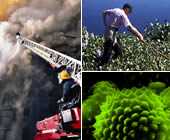Work-related Asthma

Workplace Exacerbation of Asthma Research
A 2003 statement of the American Thoracic Society (ATS) included the observation that asthma exacerbated by conditions at work was likely to be responsible for as much illness and loss of productivity as asthma caused by work. However, workplace exacerbation of asthma (WEA) had received little attention from clinicians, researchers, and public health officials. More research on the frequency and causes of WEA was needed to guide preventive actions. Dr. Paul Henneberger and others in the Respiratory Disease Research Program at NIOSH recognized this need and took action. Initially, they conducted descriptive studies of WEA by collaborating with research institutions in Maine and Colorado, and by summarizing data collected by NIOSH-supported SENSOR surveillance programs in California, Massachusetts, Michigan, and New Jersey. Then, they successfully competed for National Occupational Research Agenda (NORA) funds that supported a 5-year study of WEA. This NORA research project also benefited from additional financial support from the National Center for Environmental Health. Additional investigations followed. As of December 2014, the Respiratory Disease Research Program has produced more publications on WEA than any other research center in the world, with 13 articles in peer-reviewed journals, three book chapters, and an online educational unit (see below). The findings from several of these articles indicate that WEA is common, occurring in approximately one-fourth of working adults with asthma. A variety of workplace agents can exacerbate asthma, including irritants such as second-hand smoke and inorganic dusts, biological dusts, and low molecular weight highly reactive agents. Also, WEA cases experience many of the same adverse health consequences as individuals with asthma caused by work, and have a lower quality of life than adults who have asthma that is not related to work. Dr. Paul Henneberger chaired the ATS Work-Exacerbated Asthma Committee that developed an official ATS statement on this topic that was published in 2011. This document summarized knowledge about the descriptive epidemiology, clinical characteristics, and management and treatment of WEA; proposed a case definition for WEA; and discussed needs for prevention and research. The Respiratory Disease Research Program at NIOSH continues to pursue additional research and communication efforts related to WEA.
NIOSH Publications on Workplace Exacerbation of Asthma
Articles in Peer-reviewed Journals
- Bolen AR, Henneberger PK, Liang X, et al. The validation of work-related self-reported asthma exacerbation. Occup Environ Med,2007; 64:343-348.
- Goe SK, Henneberger PK, Reilly MJ, et al. A descriptive study of work-aggravated asthma. Occup Environ Med, 2003; 61:512-517.
- Henneberger PK. Work-Exacerbated Asthma. Current Opinion in Allergy and Clinical Immunology, 2007; 7(2):146-151.
- Henneberger PK, Hoffman CD, Magid DJ, Lyons EE. Work-related exacerbation of asthma. Int J Occup Environ Health, 2002;8:291-296.
- Henneberger PK, Deprez RD, Asdigian N, et al. Workplace exacerbation of asthma symptoms: findings from a population-based study in Maine. Arch Env Hlth, 2003; 58:781-788.
- Henneberger PK, Derk SJ, Sama SR, et al. The frequency of workplace exacerbation among health maintenance organization members with asthma. Occup Environ Med, 2006; 63:551-557.
- Henneberger PK, Liang X, Lemiere C. A comparison of work-exacerbated asthma cases from clinical and epidemiologic settings. Can Resp J, 2013;20(3):159-164.
- Henneberger PK, Liang X, Lillienberg L, Dahlman-Höglund A, Torén K, Andersson E. Occupational exposures associated with severe exacerbation of asthma. Int J Tuberc Lung Dis 2015. Accepted.
- Henneberger PK, Liang X, London SJ, Umbach DM, Sandler DP, Hoppin JA. Exacerbation of symptoms in agricultural pesticide applicators with asthma. Int Arch Occup Environ Health, 2014;87(4):423-432.
- Henneberger PK, Mirabelli MC, Kogevinas M, et al. The occupational contribution to severe exacerbation of asthma.Eur Respir J, 2010;36(4):743-50.
- Henneberger PK, Redlich CA, Callahan DB, et al. on behalf of the ATS Ad Hoc Committee on Work-Exacerbated Asthma. An Official American Thoracic Society Statement: Work-Exacerbated Asthma. Am J Respir Crit Care Med, 2011 184: 368-378.
- Lowery EP, Henneberger PK, Rosiello R, Sama SR, Preusse P, Milton DK. Quality of life of adults with workplace exacerbation of asthma. Qual Life Res, 2007;16:1605-1613.
- Vandenplas O, Henneberger PK. Socioeconomic outcomes in work-exacerbated asthma. Curr Opin Allergy Clin Immunol, 2007; 7:236-241.
Book Chapters
- Wagner GR, Henneberger PK. Asthma Exacerbated at Work. In: Bernstein DI, Chan-Yeung M, Malo J-L, Bernstein IL, editors. Asthma in the Workplace and Related Conditions, 3rd Edition. New York:Taylor and Francis, 2006, pp 631-640.
- Henneberger PK, Redlich CA. Work-exacerbated asthma. In: Sigsgaard T, Heederik D, editors. Occupational Asthma. Basel, Switzerland: Birkhäuser, 2010, pp 89-100.
- Henneberger PK, Wagner GR. Lemiere C. Chapter 22 Asthma exacerbated at work. In: Asthma in the Workplace, 4th Edition. Edited by Malo J-L, Chan-Yeung M, Bernstein DI. New York: CRC Press 2013, pp 325-335.
Educational Unit
- Henneberger PK. Work-Exacerbated Asthma. Pulmonary and Critical Care Updates (PCCU), Lesson 13, Volume 23, 2009.
- Page last reviewed: January 22, 2015
- Page last updated: January 22, 2015
- Content source:
National Institute for Occupational Safety and Health Respiratory Health Division


 ShareCompartir
ShareCompartir